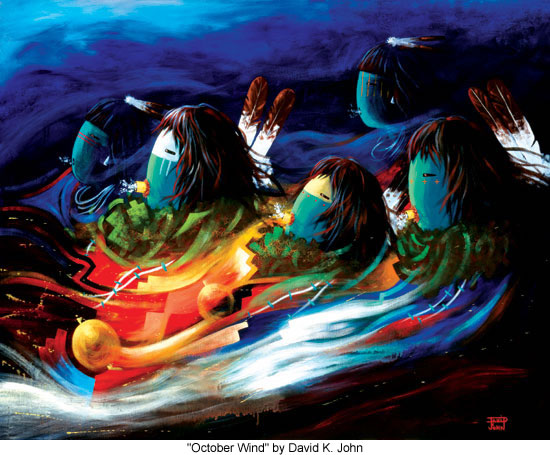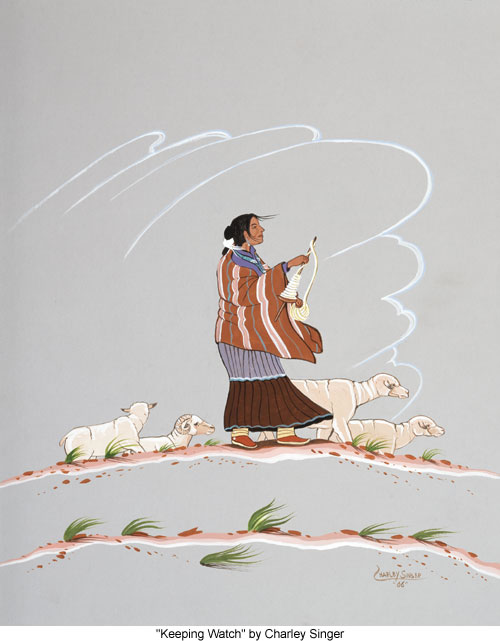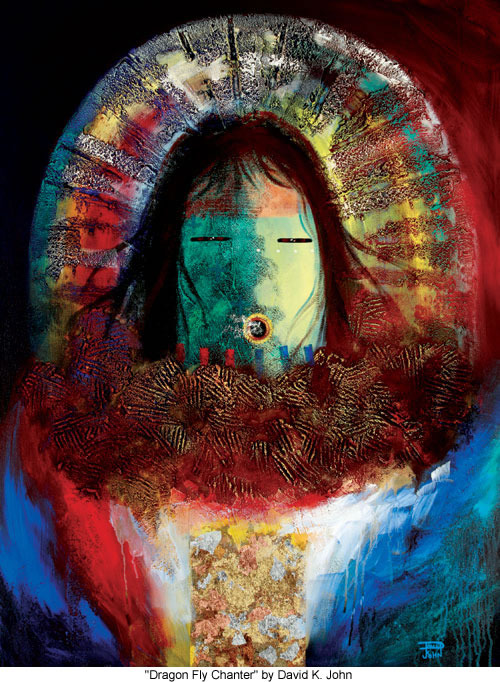 |
Canku Ota
|
 |
|
(Many Paths)
|
||
|
An Online Newsletter
Celebrating Native America
|
||
|
March 1, 2010 - Volume
8 Number 3
|
||
|
|
||
|
Kindred Spirits
|
||
|
by Kat Nichols - Flagstaff
(NM) Live
|
||
|
Two Navajo painters explore their culture from contrasting perspectives
One’s contemporary, one’s traditional. One’s brilliantly colored, the other more subtle. Two very different pictures—both handling the same subject matter—but from two very different men who will display their work together for the first time and present a taste of the yin and yang of Native American art. The Echo Canyon Art gallery will be featuring the work of Navajo painters David K. John and Charley Singer in their upcoming show “The Way of the People.” It is the first time since opening their doors in 2008 that Echo Canyon Art has had Native American artists prominently displayed. “We felt there were many places, the Museum of Northern Arizona included, that had very, very fine collections,” says Elaine Morrison, co-owner of Echo Canyon Art. “We didn’t want to show that we were in competition with those other potentially more well-established places.” The gallery’s second year of business—and the new exhibit in particular—marks a change in its offering for art lovers: a combination of both traditional and contemporary, abstract styles of Navajo painting. Morrison describes the paintings as having a kind of conversation between one another, offering different possibilities to the viewer. “We thought it would just be a wonderful juxtaposition to have these two artists looking at similar themes through very different eyes,” says Morrison. “I’m hopeful that what people will grasp onto is just the depth of meaning and feeling that’s apparent in each of these works of art.” The work of David K. John brings the Navajo culture to the public straight from the heart. He began his artistic path in high school, with his instructors encouraging him to pursue a raw talent. He credits being raised by his great-grandparents as having influenced his subject matter: scenes of ceremonies, dancers, deities and other Navajo cultural stories. “They were traditional Navajo,” says John. “Traditional people that respected the earth, plants, animals, everything that’s on earth. That’s how they live and that’s how I get a lot of my ideas, those teachings.” His work takes on an abstracted, contemporary role when getting around cultural taboos. Certain colors, symbols and designs cannot be copied except by particular individuals within the tribe. John chose to break through those barriers by letting his imagination fill in the holes. “Mine’s like putting the new and the old together, coming up with more contemporary paintings,” says John. “A lot of the paintings that I do are kind of sacred, certain things that you’re not supposed to paint. This is more my own style; I’ve come out with my own interpretation.” One example of this is in John’s interpretation of sand paintings. Medicine men create them using sand during ceremonies, recreating particular symbols in the design. When the ceremony is over, the sand painting is erased and the symbols are not to be recreated by anyone but the medicine man. John says that he lets his emotion run free on the canvas, his imagination taking over to create his own series of symbols and his own sand paintings on canvas. “I want to express something new,” says John. “A different perspective, different point of view of how you can create a painting from within your heart.”
“He’s a poor man, but a rich man,” says Steve Kay, a friend and marketer for Singer. “Financially he’s poor, but in so many ways he’s so rich and so talented and so full of information. Even though we have a language barrier, I learn so much from him, especially about the Navajo and Native American ways.” Kay sought Singer out after purchasing his painting of a white buffalo at a trading post. He began to learn from Singer, eventually becoming fast friends. Kay practices marketing as a hobby, and decided to offer his services. Together, they began producing reproductions and prints, expanding out of Arizona and into Santa Fe, N.M. “I realized that art, this is a tough business,” says Kay. “And at the same time, I just loved it so much that I ran with it. So I thought, ‘You know what, this will just be my way of giving it back.’” Kay worked with Morrison to place Singer’s work in the upcoming show. His pieces greatly contrast with John’s in terms of style. While John’s use extensive color and symbolism, Singer’s work takes a more simplistic approach. He uses cooler colors, often a background of black, blue or gray. Singer loves horses and features them in many of his works. The Four Horses and the Four Sacred Peaks of Navajo lore are frequently featured, their colors representing the four directions. “I think that it’s so wonderful,” says Kay. “Just to see it and realize what the four horses mean, they’re all different colors and stand for different life cycles, and the four peaks … everybody should have a chance to at least see Charley’s art.” The show will officially open on the First Friday Art Walk, but a reception for David K. John will be held the day before. The Art Walk has been drawing giant crowds to the gallery, with people often standing elbow to elbow within the space. Morrison hopes that by holding the reception a day earlier, visitors will have a better chance to visit with the artist and view the exhibition. “I think it’s going to be extremely cool,” says Kay. “I think it’s going to be really neat to have two excellent artists that are going two different directions in their style. I think it’s going to be the best of two worlds there.” “The Way of the People” opens Fri, Feb. 5 and runs through March 31 at Echo Canyon Art, 14 N. San Francisco. The opening reception with David K. John will be Thu, Feb. 4 from 5–7 p.m. For more information, call 255-0349 or visit www.echocanyonarts.com. To see more examples of work by John and Singer, visit www.davidkjohn.com or www.charleysinger.com.
David
K. John
Charley
Singer |
|
insert map here
|
|
|
||
|
|
||
| Canku Ota is a free Newsletter celebrating Native America, its traditions and accomplishments . We do not provide subscriber or visitor names to anyone. Some articles presented in Canku Ota may contain copyright material. We have received appropriate permissions for republishing any articles. Material appearing here is distributed without profit or monetary gain to those who have expressed an interest. This is in accordance with Title 17 U.S.C. Section 107. | ||
|
Canku Ota is a copyright ©
2000, 2001, 2002, 2003, 2004, 2005, 2006, 2007, 2008, 2009, 2010
of Vicki Barry and Paul Barry.
|
||
 |
 |
|
|
The "Canku
Ota - A Newsletter Celebrating Native America" web site and
its design is the
|
||
|
Copyright ©
1999, 2000, 2001, 2002, 2003, 2004, 2005,
2006, 2007, 2008, 2009, 2010
of Paul C. Barry.
|
||
|
All Rights Reserved.
|
||

 In
contrast to John is Charley Singer, whose own life is as filled
with history as his paintings are filled with elements of traditional
Navajo culture. He lives a simple life in a hogan on the Navajo
reservation without electricity and speaks little English. Raised
by Little Singer, a prominent medicine man for which Little Singer
School outside of Leupp is named, Singer gained an expansive knowledge
of his culture.
In
contrast to John is Charley Singer, whose own life is as filled
with history as his paintings are filled with elements of traditional
Navajo culture. He lives a simple life in a hogan on the Navajo
reservation without electricity and speaks little English. Raised
by Little Singer, a prominent medicine man for which Little Singer
School outside of Leupp is named, Singer gained an expansive knowledge
of his culture.


